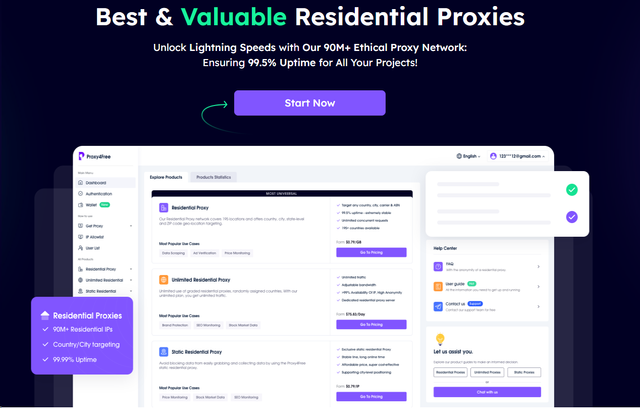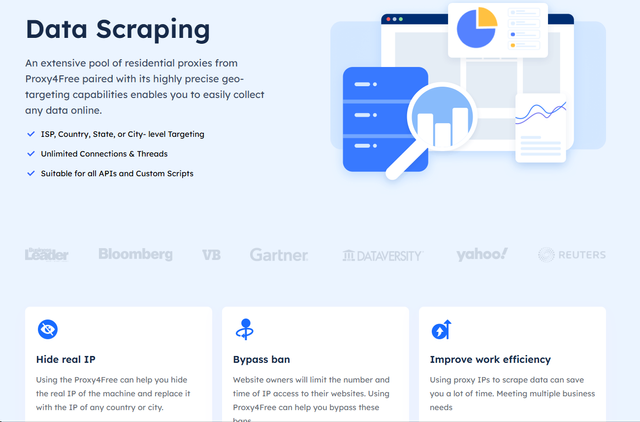Guide to Optimizing Multi-Threading and Concurrent Connections for Proxies IPs
In today's data-driven Porfiles, the dependence of online business on Proxies is becoming more and more evident. Whether it is real-time data crawling, fast traffic management, or concurrent request support in a multi-user environment, Proxies IP's multi-threading and concurrent connection technologies are core tools. These technologies not only enhance the operational efficiency of the Proxies system, but also bring more flexibility in business operations.
For Proxies IP management systems, understanding and effectively utilizing multithreading and concurrent connections is key to staying competitive. Multi-threading techniques allow the system to process multiple requests at the same time, while concurrent connections can further increase the number of simultaneously active connections, which together ensure a smoother user experience. This article will explain the practical application of these concepts step-by-step, delving into their unique advantages in Proxies IP management, as well as the technical challenges that organizations may face during their use and how to deal with them. In this way, it will not only help users better understand the practical application of Proxies IP technology, but also provide guidance for enterprises to optimize their business processes.
Basic concepts of multithreading and concurrency
Multi-threading and concurrent connections are core concepts that enhance the performance of Proxies IP management. With multithreading, a Proxy Service can handle multiple requests at the same time, and this parallel processing significantly improves the efficiency of task execution.

For example, web servers are able to cope with a large number of client requests during high loads by multithreading, while maintaining fast responses and avoiding the congestion caused by single threads.
Concurrent connections, on the other hand, refer to the number of simultaneous connections maintained within a Proxies system at a given moment. Highly concurrent connections are especially important in Proxies management, especially when the system needs to handle a large number of requests at the same time. With multi-threading and concurrent connections, Proxy Services are not only able to handle more traffic, but also allocate resources more flexibly to provide a smoother experience for users.
Limitations of Single-Threaded Proxies Management
The core function of Proxy Service is to act as an intermediary between the client and the target server, guaranteeing the security and privacy of data transmission and improving the overall efficiency. However, in single-threaded mode, the processing power and response speed of Proxies management will be significantly limited. The single-threaded management model can only process each request one by one, waiting for the completion of the previous task before processing the next request. This design leads to higher latency, which reduces the response speed of the Proxies service and affects the user experience.
In high-frequency request scenarios such as data collection and application testing, it is especially difficult to meet the demand in single-threaded mode. When a large number of client requests are centrally influxed, single-threaded systems are often overloaded, resulting in higher latency and affecting system performance and user experience.
Efficiency Benefits of Multi-Threaded Proxies Management
Multi-threading technology is an effective way for Proxies management to break through the bottleneck of single-threading. Multi-threading allows Proxy Services to handle multiple requests at the same time and is no longer limited to the mode of completing tasks one by one, which significantly improves the system's operational efficiency and response speed.
In scenarios such as data collection, multi-threading can assign requests to different Proxies IPs, dispersing the request pressure and avoiding high-frequency requests concentrated on a single IP to trigger the server's blocking mechanism. By assigning independent Proxies IPs to each thread, the risk of being blocked can be significantly reduced, accelerating data collection and improving crawling efficiency. It is worth noting that although multi-threading significantly improves speed, an unreasonable number of requests may lead to server blocking. Therefore, it is necessary to reasonably configure the number of concurrent connections and follow the principle of compliant crawling to ensure that business operations are legal and compliant.
The Important Role of Concurrent Connections

The number of concurrent connections indicates the number of active connections within the Proxies management system at the same moment. The upper limit of this value is not only affected by Proxy Service bandwidth and processing capacity, but also constrained by network resource configuration and proxy type (e.g., HTTP, SOCKS, etc.). In a highly concurrent operating Porfiles, a reasonable concurrent connection configuration can help to improve the overall system performance and user experience.
Concurrent connections have a direct impact on the speed and efficiency of the system and are closely related to the balance between supply and demand of Proxies resources. When there are sufficient Proxies resources, a higher number of concurrent connections can ensure fast task completion and improve system response speed; conversely, when Proxies resources are in short supply, too high a number of concurrent connections may increase latency or even trigger system congestion. Therefore, when choosing Proxies, it is crucial to ensure that the system has a reasonable upper limit of concurrent connections to cope with large-scale data requests.
The Challenges of Multi-Threading and Concurrent Connections
Although the application of multithreading and concurrent connections improves the performance of Proxies, it also poses a number of technical challenges, notably:
Resource Competition: Multiple threads may request the same resource at the same time, resulting in system performance degradation.
Data Consistency: Multi-threaded access to shared data can easily trigger data inconsistency issues that need to be managed synchronously.
Thread Leakage: Threads that are not properly terminated may exhaust system resources and affect system stability.
To address the above challenges, Proxies management systems often use a variety of technical strategies to optimize thread management and concurrent connection configuration. For example, the establishment of a thread pool can reduce the frequent creation and destruction of threads and lower the system load; thread scheduling and resource allocation priority management can ensure that critical tasks are given higher priority in resource allocation; data synchronization management prevents concurrent modification of shared resources by multiple threads through the use of thread locks and other mechanisms, thus ensuring data consistency. With these techniques, the stability and performance of Proxies in a highly concurrent Porfiles environment will be effectively guaranteed.
How to Optimize Multithreading and Concurrency
For effective management of multithreading and concurrent connections, here are a few common optimization strategies:
Thread Pool Management: Reduce resource consumption and ensure that threads can be reused cyclically through a fixed number of thread pools.
Thread scheduling: By setting the priority of different threads, resources are reasonably allocated and important tasks are prioritized.
Data synchronization: With the help of thread locks and other mechanisms to achieve synchronized access to shared data, to avoid conflicts caused by resource competition.
Exception handling: error handling mechanisms are set up in multi-threaded code to avoid system interruptions by catching and handling exceptions.
Real-time monitoring: Detect thread execution status and system load through monitoring tools to identify and resolve performance bottlenecks in a timely manner.
These strategies not only have significant results in optimizing the configuration of multi-threaded and concurrent connections, but also help Proxies management systems maintain stable performance in complex Porfiles environments.
Multithreading and Concurrent Connections in Proxies Applications
Taking data capture as an example, Proxies IP combined with multi-threading technology can effectively improve the efficiency of web page data capture. Multi-threading technology can assign different Proxies IPs to each crawling request, thus dispersing the request pressure and reducing the risk of being blocked by the target server. In addition, the concurrent connection configuration of the Proxies management system can also significantly increase the request speed, realizing efficient and fast high-volume data capture.

Here we recommend the use of Proxy4Free Residential Proxies ServiceProxy4Free Residential Proxy Service is recommended here! As a leading IP Proxies service provider, Proxy4Free supports high speed internet connection with unlimited traffic and bandwidth of over 30MB/S, and flexible choice of Proxies from 195 countries and regions around the globe. its service has supported over 20,000+ individual users and 100+ enterprise users, and is especially suitable for Cross-border market research advertising monitoring advertising monitoring advertising monitoring, price comparison and other business scenarios that require high concurrency and high traffic processing.

Proxy4Free also provides users with high anonymity and strong security to ensure that data privacy is not compromised. Proxies are easy to configure and use, making your network operations more efficient. For multi-threaded and concurrent connections that require stable support, Proxy4Free is the ideal choice for an efficient network experience.

Click on the link to try it out now!
Choosing a high-quality Proxies service is crucial for applications with multiple threads and concurrent connections. With professional Proxies, organizations and developers can more easily handle large-scale requests while safeguarding the security of data transmission. Our Proxies not only come with high standards of encryption and Secure Proxy, but also support seamless integration with a wide range of proxy management tools to help users automate data collection and efficient network operations.
For users with high demand for globalized data capture, social media monitoring or content management, we provide Proxies with no extra charge on concurrent connections, so users don't need to worry about the extra expenses increased by concurrent connections and enjoy a more efficient and stable service experience.
Conclusion
Multi-threading and concurrent connection technologies are key elements in the Proxies IP management system. Properly configured, these technologies enable Proxies to maintain efficient and stable responses when dealing with high-volume requests. Multi-threading technology improves the request processing speed, and concurrent connections guarantee smooth operation in a multi-tasking Porfiles environment. By optimizing the configuration of multithreading and concurrent connections, Proxies can provide users with more efficient network support and meet the needs of rapid business expansion.
When using Proxies, the reasonable use of multi-threading and concurrent connection technology can efficiently fulfill the needs of data collection and information processing. At the same time, by choosing professional Proxy IP management services, users can not only significantly improve system performance, but also obtain comprehensive Secure Proxy protection and stability support.